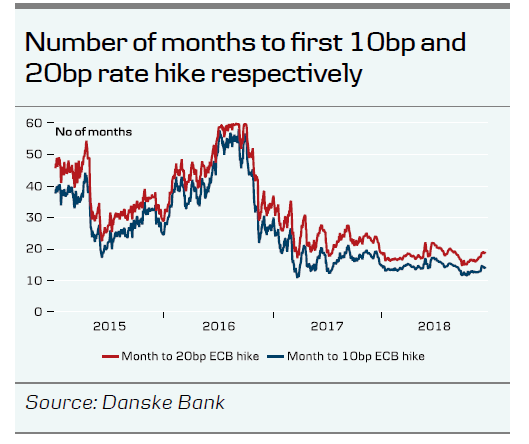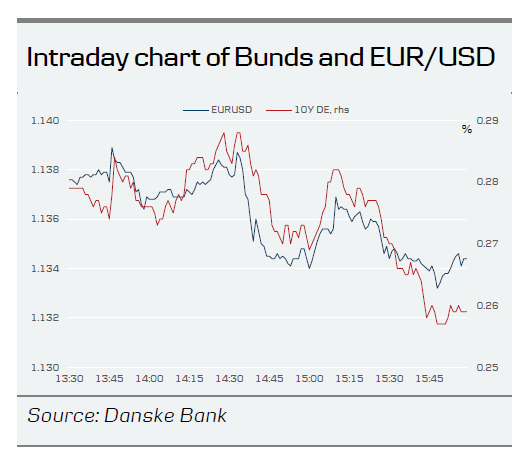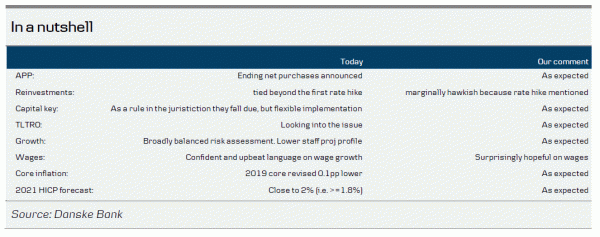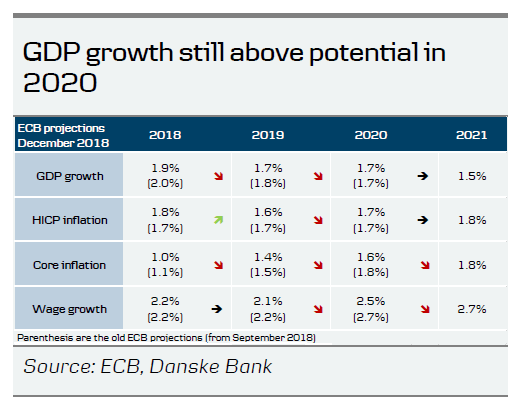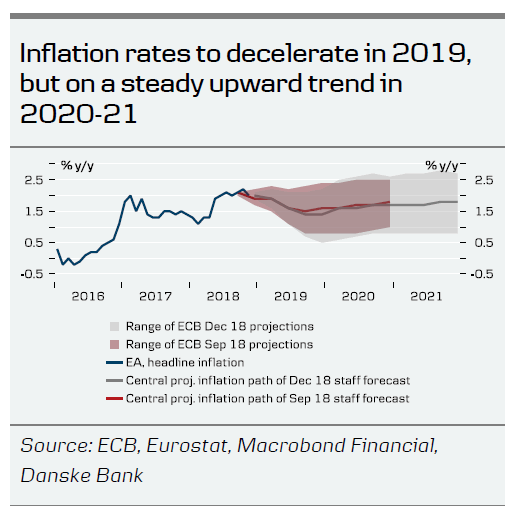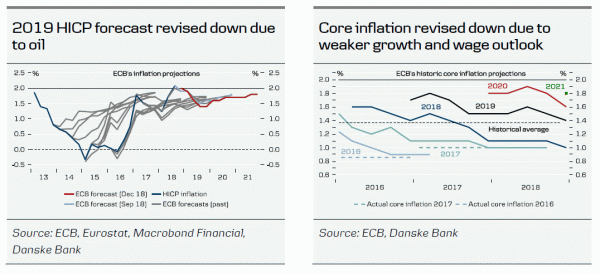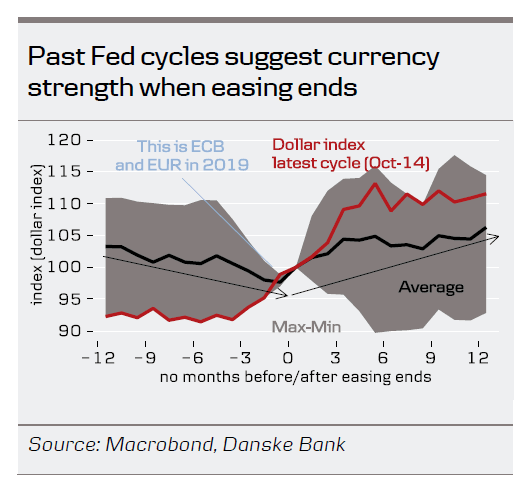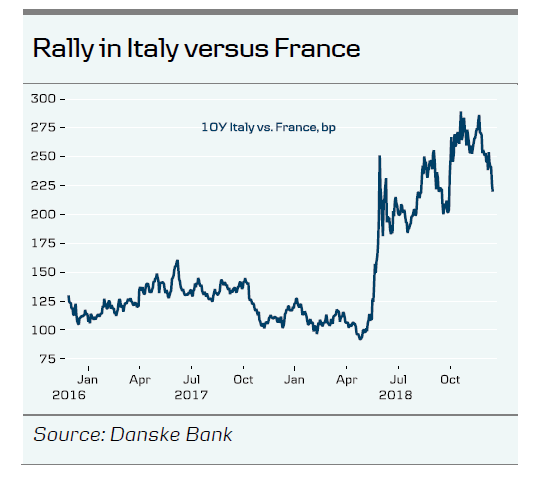- Today, the ECB formally announced an end to the asset purchase programme by the end of the year. The decision was widely expected, but we find great interest in the fact that the ECB now ties the reinvestment period up to the first rate hike – and that the notion of the next step is a hike from the ECB, which would be a hawkish signal.
- Somewhat downbeat and hopeful message on growth, inflation and wages.
- Markets generally traded within a narrow band, and today’s meeting does not alter our expectation of the ECB hiking rates in December 2019.
Surprisingly soft Draghi
As expected the ECB announced a formal end to its programme, but otherwise sounded relatively dovish. The important growth risk assessment is broadly balanced, though with the significant change of risks moving to the downside. That mirrors the 2011 narrative where ECB changed its risk assessment to be on the downside. Draghi added a risk factor (geopolitics) to the existing risks of protectionism, vulnerabilities in emerging markets andfinancial market volatility.
Naturally the focus on reinvestments was high, however, and the ECB did indicate that the redemptions will ‘as a rule’ be reinvested in the jurisdiction in which they fall due, but also allowing for flexible implementation to reflect the new capital key. Furthermore, reinvestment will be placed over 1 year (and not 3-month as now) which will try to avoid steep mispricing in the government bond market. Finally, the ECB will also reinvest below the deposit rate. Regarding the reinvestment period, we got probably the only comment that we consider on the hawkish side as the reinvestments are now tied past the first rate hike. However, it is only hawkish because it confirms that the next move from the ECB is a hike. On TLTRO, there was as expected no new information on this. The ECB reiterated that it is aware of the situation and is looking into this. We have previously argued for TLTROs and expect this to be announced in March next year and implemented in June 2019. Finally, Draghi also said that markets had understood the forward guidance on rates. That comment is somewhat surprising to us as markets currently only point to a 20bp hike inJune 2020.
Slower growth, more gradual core inflation path
The ECB also released new economic forecasts at the meeting, which – as we expected – saw downward revisions both in the near-term growth and inflation outlooks but unchangedconfidence in the long-term build-up of underlying inflation pressures:
1. Euro area landing on a path closer to potential. Draghi acknowledged that the latest incoming data was weaker than expected, which all else equal suggests slower growth momentum ahead. But domestic demand continues to underpin growth and the key drivers of the recovery are still in place. In light of this, ECB revised down its GDP forecasts for 2018 and 2019 to 1.9% and 1.7%, respectively, but maintained the 2020 forecast at 1.7% (i.e. still growth above potential). In a slight dovish tilt, the balance of risks was now seen moving to the downside (without quite being there!) due to geopolitical factors, protectionism, vulnerabilities in emerging markets and financialmarket volatility.
2. Wages will be an uneven inflation force, but core uptick will come. While the ECB expects headline inflation to decrease in the coming months, underlying inflation is expected to increase over the medium term, also due to broad-based wage growth (2.5% y/y in Q3 18 – highest since 2008). Draghi acknowledged that the pass-through from higher wages to core inflation has yet to materialise and cautioned that it might not be uniform across the region, reflecting the different economic conditions in the euro area. Although core inflation forecasts for 2019 and 2020 were revised down, the ECB’s long-term inflation confidence is clearly alive, with core inflation projected at 1.8% by2021.
FX: getting closer to the EUR rebound – but not there just yet
The FX market saw little reaction on the confirmation to end the APP and the introduction of the so-called ‘enhanced’ forward guidance. However, EUR slid initially during the press conference on soft comments from Draghi on the balance of risks. Crucial for the EUR is the fact that forward guidance on rates remained time-dependent which means that rate hikes are not imminent; this, on the one hand, puts a lid on EUR strength near term. However, the fact that reinvestments were linked to the first rate hike is a key hint that the next move from the ECB is higher policy rates which is in itself a hawkish signal and a key cue to the FX market that we are now exiting ‘crisis mode’ in the eurozone; this, on the other hand, puts a floor under EUR. On the whole, today’s ECB messages do not change our view that EUR/USD is a range around 1.13 on 0-3M horizon with potential for a clear rebound mid 2019 into the 1.20s. We are long USD carry at present but positioned for a EUR/USD rebound beyond Q1 via options in our FX Top Trades 2019 – our guide on howto position for the coming year, 4 December 2018.
A ‘balanced’ view
The ECB December meeting has previously been bearish for rates. In 2016, 10Y German government bond yields rose some 20bp at the start of December. In 2017, 10Y German government yields rose some 50bp. However, today the ECB struck a much more balanced tone and given the comments on the reinvestments, there will still be a strong bias towards buying German government bonds in 2019 by the ECB. We expect that the ECB will have to reinvest some EUR40bn in German government bonds in 2019. Thus, it is difficult tosee the same negative reaction in the Bunds as we saw in 2017.
Looking forward then the range-trading we have seen in Bunds between 0.25% to 0.75% since mid-2016 is likely to continue well into 2019.
Given that the ECB is moving very slowly, there is also plenty of support for the peripheral markets going into 2019 even though there was limited discussion on TLTROs. Hence, the rally we have seen recently in e.g. Italy is likely to continue into next year especially as the Italian government has been much more ‘constructive’ on the budget deficit for 2019. However, there is still a significant supply as well as overinvestment in Italian government bonds, and over time the ECB should reinvest less in Italy. Thus, we still need to have a high risk premium on the Italian government bonds relative to core-EU bonds and it is difficult to see the 10Y spread between Italy and Germany moving much below 250bp inthe short term.




